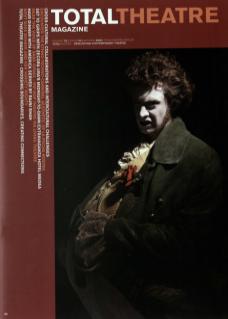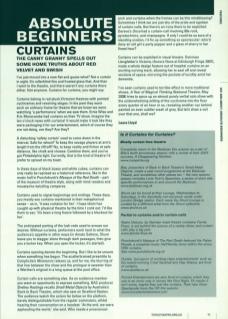I've just moved into a new flat and guess what? Not a curtain in sight. It's rollerblind this and frosted glass that. And then I went to the theatre, and there weren't any curtains there either. Not anymore. Curtains for curtains, you might say.
Curtains belong in red plush Victorian theatres with painted cycloramas and revolving stages. In the past they were such an ordinary frame for theatre that we knew we were watching 'a performance' when we saw them. Ernie Wise and Eric Morecambe had curtains on their TV show. Imagine the ten o'clock news with curtains! It would make it look like they were packaging it for our entertainment, which of course they are not doing, are they? Are they?
A disturbing 'safety curtain' used to come down in the interval. Safe for whom? To keep the savage players at arm's length from the riffraff? No, to keep reality and fiction at safe distance, like chalk and cheese. Combine them, and you've got Philadelphia light. Currently, that is the kind of theatre I'd prefer to spread on my toast.
In these days of black boxes and white cubes, curtains can only really be reprised as a historical reference, like in the music hall in Punchdrunk's Masque of the Red Death – part of the museum of theatre style, along with mind-readers and moustache-twizzling comperes.
Curtains used to signal beginnings and endings. These days, you mostly see curtains mentioned in their metaphorical sense – as in, ‘it was curtains for her'. I hope idiom has caught up with physical theatre by the time I conk out. I'd like them to say: 'It's been a long freeze followed by a blackout for her.'
The anticipated parting of the lush reds used to arouse our desires. Without curtains, performers work hard to whet the audience's appetite in other ways in Amato Saltone, Shunt leave you to stagger alone through dark passages, then give you a locker key. (When you open the locker, it's started).
Curtains opening denote the beginning. But I like to be unsure when something has begun. The scatterbrained preamble to Complicite's Mnemonic relaxes us, and for me, the blurring of that line between the show and the prologue is sweeter than a Werther's original in a long queue at the post office.
Curtain calls are something else. As an audience-member you want an opportunity to express something. BAC producer Shelley Hastings recalls Small Metal Objects by Australia's Back to Back Theatre, which she saw on Stratford Station. The audience watch the actors far below on the platform, barely distinguishable from the regular commuters, whilst hearing their conversation on a headset. 'At the end, we were applauding the world,' she said. Who needs a proscenium arch and curtains when the frames can be this mindblowing? Sometimes I think we are just shy of the pride and egotism of curtain-calls. But there's an irony there to be exploited: Derevo's Once had a curtain-call involving 80s rock, pyrotechnics, and champagne. If only I could be so sure of a standing ovation, I'd fix up something as spectacular: who'd deny an old girl a party popper and a glass of sherry in her finest hour?
Curtains can be exploited in visual theatre. Dulcinea Llangfelder's Victoria (Aurora Nova at Edinburgh Fringe 2007), made a whole design feature out of hospital curtains on an exciting curving track, allowing her to seal off and reveal sections of space, mirroring the pockets of lucidity amid her dementia.
I've seen curtains used to terrible effect in more traditional shows. A Year of Magical Thinking (National Theatre, May 2008) tries to spice up an almost purely verbal solo show with the underwhelming wilting of the cyclorama into the floor every quarter of an hour or so, revealing another cyc behind painted an even subtler wash of grey. But let's draw a veil over that one, shall we?

